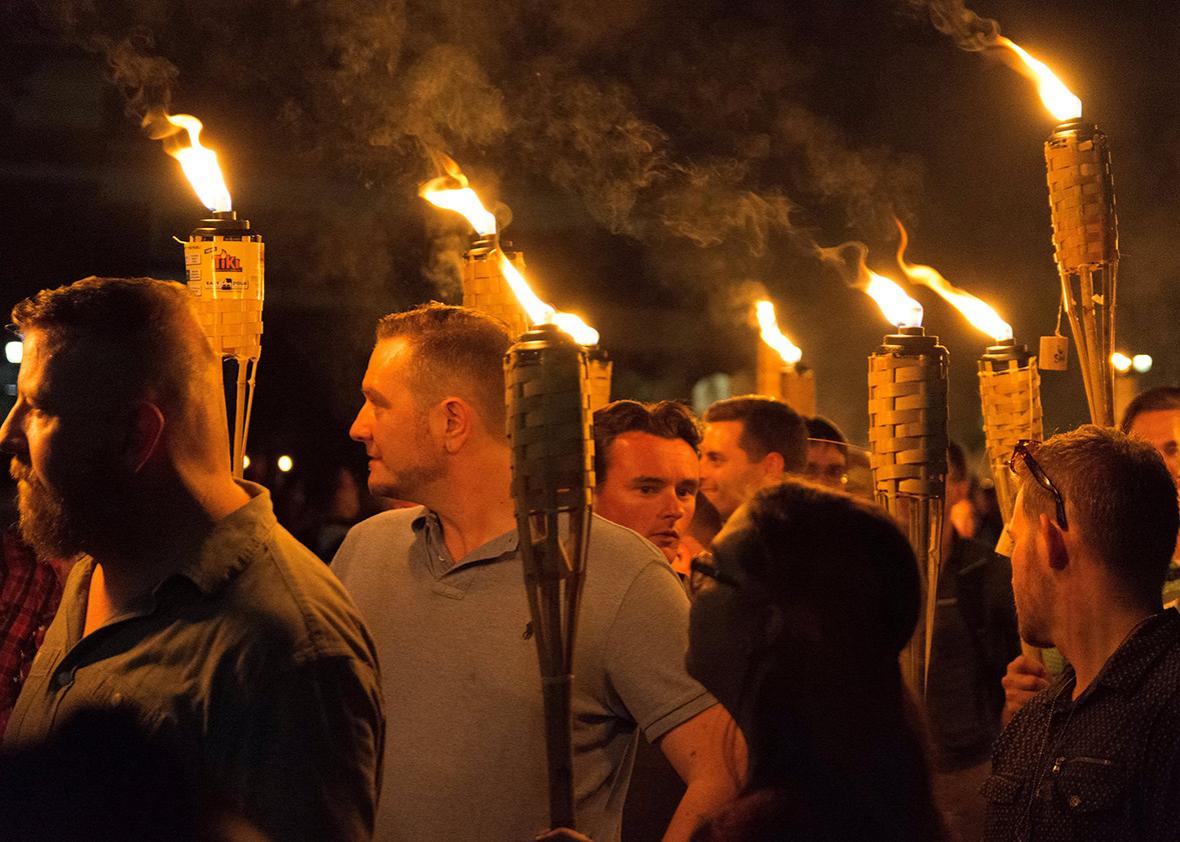Want to listen to this article out loud? Hear it on Slate Voice.
The alt-right’s Tiki-torch, khaki-pants parade on Friday night has birthed many a “Hitler luau” joke. But as journalist Ezekiel Kweku noted on Twitter this weekend, white supremacy has a history of cloaking itself in far more clownish attire. “That Klansmen dressed like fanciful numskulls was part of the way that they kept people from acknowledging their terror,” Kweku wrote.
Kweku’s point comes from the work of historian Elaine Frantz Parsons. In her book Ku-Klux: The Birth of the Klan During Reconstruction and an extremely interesting 2005 article in the Journal of American History, Parsons explored the dark humor and cultural references the Reconstruction-era Ku Klux Klan used when the group was new. Those familiar mass-produced white robes, elaborate titles, and hierarchies are an artifact of the second rising of the KKK, in the early 20th century. But in that first half-decade after the end of the Civil War, Klan members were running around in women’s clothes, wearing fake beards, serenading victims with out-of-tune ditties, and generally acting the fool—before, during, and after committing acts of violence against freedpeople.

North Carolina Department of Natural and Cultural Resources
One of the most telling parallels between how the Klan operated in the 1860s and how the alt-right operates today lies in what we might now call “trolling.” Drawing from racist stereotypes, and using performance techniques adopted from minstrelsy, carnival, or the circus, Klan members forced their victims to watch (and participate in) little comedy sketches. Because a Klan attack was scripted like a performance, the victim of the attack was transformed into a passive spectator—significant, as Parsons writes, in “the Reconstruction-era South, where freed people were increasingly asserting their own agency.”
The Klan delighted in the terrified reactions of their victims. Describing the actions of Ku Kluxers who marched in a Mardi Gras parade in Memphis in 1872, after conservative Democrats regained power, a newspaper writer reported that some of the marchers carried ropes. “It was a favorite bit of pleasantry to lasso a negro,” the writer noted. “No violence was offered but the contortions and grimaces of the captives were highly amusing.” The public pain and fear of these victims of Klan “pleasantries” offered visual confirmation that order had been restored in the South.
Besides being fun for the perpetrators, performance also had a cloaking quality. As Parsons writes, “Klansmen used performance for reasons that lay far beyond any hopes of obscuring their identities or cowing their victims.” By making their violence appear theatrical, Klansmen could essentially confuse authorities, who would take time to decide whether the perpetrators were joking. Performances also misdirected outside audiences (like Northerners), who might have trouble figuring out what the Klan was all about. “The Klan was conceived in a tableau vivant, nurtured by minstrels and serenaders, housed by circuses and masquerades, and given an afterlife in Mardi Gras processions,” Parsons writes. All of that playing with current forms of popular culture meant that Klan violence confused observers—especially white Northerners, who were fans of minstrelsy, too, and quite ready to laugh at a black person who was the butt of a joke.

Giles County Historical Society
That first iteration of the Klan had no fear of making itself ridiculous. As Parsons said when I reached her by phone to ask about the images coming out of Charlottesville, Virginia, Ku Kluxers in the Reconstruction era would attend tournaments held as public events in the South and “ride in on an old broken-down steed, or backwards,” which was in actuality a power move. “It was this thing like, ‘We’re laughing at ourselves, aren’t we losers, aren’t we failures, but here we are. We’re still part of this cause, even though we now recognize it’s a lost cause. We’re sticking with it.’ These people had confidence that eventually whiteness will prevail, because that’s how history works.” The same goes for the KKK members who would wear women’s clothes, or a suit of clothes turned inside out, or false beards.
Parsons points out that the flashy showiness of Klan theatrics worked to their advantage in spreading their ideas. Since they didn’t have “robust and official channels of communication,” and needed to maintain a level of secrecy, newspaper reports of their parades and appearances were very useful recruitment tools, spreading the group’s ideas at little risk to them. “Performative representations of the Klan,” Parsons writes, “frequently preceded or arrived alongside the spread of Klan violence.” In a painful irony, circuses and minstrel shows, which had provided the theatrical vocabulary for acts of Klan violence, included Klan-themed skits in their programs; these representations then provided cover for the Klan, who could continue to claim to Northern observers horrified at the violence that the Klan was an imagined entity.
The history of Klan performance doesn’t exactly tell us what’s going on today, but it reminds us to take white supremacists’ “jokes,” costumes, and aesthetics seriously. The khakis and Tiki torches in Charlottesville were a strong performance of normalcy. As Parsons said, “Tiki torches are like the ultimate suburban weapon. It’s almost like if they were bashing people with barbecue implements. It’s like the rising of the outer suburbs or something.” Tiki torches, tactical gear, medieval crests and shields: They’re all statements of power.
